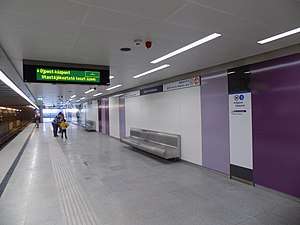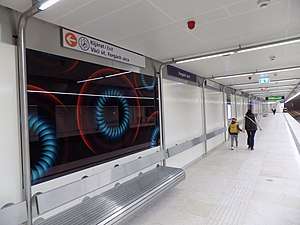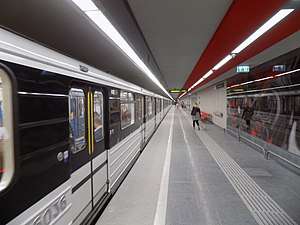Metro Line M3 (Budapest Metro)
Line 3 (Officially: North-South Line, Metro 3 or M3, and unofficially: Blue Line) is the third and longest line of the Budapest Metro. It runs in a general north-south direction parallel to the Danube on the Pest side, roughly following Váci út south from Újpest to the city center, then following the route of Üllői út southeast to Kőbánya-Kispest. Its daily ridership is estimated at 626,179. Like Line 1, it does not serve Buda.
| Metro Line M3 | |||
|---|---|---|---|
 | |||
| Overview | |||
| Type | Rapid transit | ||
| System | Budapest Metro | ||
| Status | Operational | ||
| Termini | Nagyvárad tér Újpest-Központ | ||
| Stations | 20 (5 closed) | ||
| Line number | Line 3 ("Blue metro") | ||
| Operation | |||
| Opened | December 31, 1976 | ||
| Operator(s) | BKV | ||
| Technical | |||
| Line length | 16.5 km (10 mi)[1] | ||
| Track gauge | 1,435 mm (4 ft 8 1⁄2 in) | ||
| Electrification | 825 V DC | ||
| Operating speed | 80 km/h[2] | ||
| |||
Metro 3 | ||||||||||||||||||||||||||||||||||||||||||||||||||||||||||||||||||||||||||||||||||||||||||||||||||||||||||||||||||||||||||||||||||||||||||||||||||||||||||||||||||||||||||||||||||||||||||||||||||||||||||||||||||||||||||||||||||||||||||||||||||||||||||||||||||||||||||||||||||||||||||||||||||||||||||||||||||||||||||||||||||||||||||||||||||||||||||||||||||||||||||||||||||||||||||||||||||||||||||||||||||||||||||||||||||||||||||||||||||||||||||||||||||||||||||||||||||||||||||||
|---|---|---|---|---|---|---|---|---|---|---|---|---|---|---|---|---|---|---|---|---|---|---|---|---|---|---|---|---|---|---|---|---|---|---|---|---|---|---|---|---|---|---|---|---|---|---|---|---|---|---|---|---|---|---|---|---|---|---|---|---|---|---|---|---|---|---|---|---|---|---|---|---|---|---|---|---|---|---|---|---|---|---|---|---|---|---|---|---|---|---|---|---|---|---|---|---|---|---|---|---|---|---|---|---|---|---|---|---|---|---|---|---|---|---|---|---|---|---|---|---|---|---|---|---|---|---|---|---|---|---|---|---|---|---|---|---|---|---|---|---|---|---|---|---|---|---|---|---|---|---|---|---|---|---|---|---|---|---|---|---|---|---|---|---|---|---|---|---|---|---|---|---|---|---|---|---|---|---|---|---|---|---|---|---|---|---|---|---|---|---|---|---|---|---|---|---|---|---|---|---|---|---|---|---|---|---|---|---|---|---|---|---|---|---|---|---|---|---|---|---|---|---|---|---|---|---|---|---|---|---|---|---|---|---|---|---|---|---|---|---|---|---|---|---|---|---|---|---|---|---|---|---|---|---|---|---|---|---|---|---|---|---|---|---|---|---|---|---|---|---|---|---|---|---|---|---|---|---|---|---|---|---|---|---|---|---|---|---|---|---|---|---|---|---|---|---|---|---|---|---|---|---|---|---|---|---|---|---|---|---|---|---|---|---|---|---|---|---|---|---|---|---|---|---|---|---|---|---|---|---|---|---|---|---|---|---|---|---|---|---|---|---|---|---|---|---|---|---|---|---|---|---|---|---|---|---|---|---|---|---|---|---|---|---|---|---|---|---|---|---|---|---|---|---|---|---|---|---|---|---|---|---|---|---|---|---|---|---|---|---|---|---|---|---|---|---|---|---|---|---|---|---|---|---|---|---|---|---|---|---|---|---|---|---|---|---|---|---|---|---|---|---|---|---|---|---|---|---|---|---|---|---|---|---|---|---|---|---|---|---|---|---|---|---|---|---|---|---|---|---|---|---|---|---|---|---|---|---|---|---|---|---|---|---|---|---|---|---|---|---|---|---|---|---|---|---|
| ||||||||||||||||||||||||||||||||||||||||||||||||||||||||||||||||||||||||||||||||||||||||||||||||||||||||||||||||||||||||||||||||||||||||||||||||||||||||||||||||||||||||||||||||||||||||||||||||||||||||||||||||||||||||||||||||||||||||||||||||||||||||||||||||||||||||||||||||||||||||||||||||||||||||||||||||||||||||||||||||||||||||||||||||||||||||||||||||||||||||||||||||||||||||||||||||||||||||||||||||||||||||||||||||||||||||||||||||||||||||||||||||||||||||||||||||||||||||||||
History
The first decree for the third line was made in 1968,[3] construction started in 1970, the first section was opened in 1976 with six stations. The southern direction was complemented with five more stations in 1980, and the northern one in 1981, 1984, and 1990 with nine stations, reaching its current length of 20 stations and 16.5 km (10 mi), the longest line in Budapest.[2][3] Soviet-made 81-717/714 carriages (prevalent in many Eastern Bloc metro systems) operate on this line. Operation started with 4 units in 1976, expanded to 6 units in 1984.[4] Six unit-trains provide space for 1,097 people.[1] It was planned for a daily ridership of 800,000 people.[1]
Line 3 runs in a north-south direction (more exactly, from north-northeast to southeast) through the city and connects several populous microraion with the downtown.[5] It has a transfer station with Line 1 and Line 2 at Deák Ferenc tér, and a transfer station for Line 4 at Kálvin tér.
Ongoing reconstruction
Mayor of Budapest Gábor Demszky was warned in 2006[6] by BKV that the line would soon need reconstruction, but no steps towards this were made before the new mayor István Tarlós took office in 2010. The trains started burning or smoking multiple times, but this has caused neither fatalities nor serious injuries as of yet. Tarlós reacted by ordering the retirement of all trains that were more than 40 years old. He also started the reconstruction of the tracks, because they were also reported as hazardous. In 2014 the mayor's administration finished laying out the plans for the complete reconstruction of the line and Viktor Orbán's government allowed the local government to finance the reconstruction of the trains by taking up loans. Repayment of the loans was guaranteed by the national government in case the municipal government was not able to pay. The municipal government requested EU funds to finance the reconstruction of the underground infrastructure (tunnels and stations), the national government assured it would provide financing in case no or less EU funds were obtained than the necessary amount.
The first metro train was handed over in January 2016 to the Russian Metrowagonmash (the original manufacturer) to be reconstructed.[7] Tarlós had preferred buying new trains, but he had been overwritten by the Orbán-government.[8] The prototype of the reconstructed trains entered service on March 20, 2017.[9] Since then, the number of reconstructed trains serving the line is scheduled to increase by 2 trains every month.
On September 4, 2017 the contracts for reconstructing the whole tunnel and the stations of the northern section were signed, thus effectively starting the reconstruction. The stations were to be finished by December 31, 2018, but eventually they were only opened on March 30, 2019. The reconstruction of the southern section (Népliget – Kőbánya–Kispest) was started on April 6, 2019. The plan is to upgrade the metro at Arany János utca and Ferenciek tere from 9 March 2020,[10] and from July 2020 at the metro stations of the Corvin Negyed and Semmelweis Klinikák. Reconstruction between the Nyugati Pályaudvar and Semmelweis klinikák will begin after the southern section has been commissioned. At these stops, the underground trains pass without interruption during work in the passenger compartment. Overhauling the tunnel is set to be completed by August 24, 2020. After this reconstruction, the renewed train will more likely stay in service for more than 20 years before they going to have to be replaced.[11]
Criticism
Civil groups voiced their concerns over the lack of accessibility and air-conditioning.[12] In response, Tarlós promised modular AC units would be installed on the trains and the government agreed to make 18 out of the 20 stations accessible.[13][14]
Timeline
| Segment[2][3] | Date opened | Length |
|---|---|---|
| Deák Ferenc tér – Nagyvárad tér | 31 December 1976 | 4.1 km |
| Nagyvárad tér – Kőbánya–Kispest | 29 March 1980 | 4.9 km |
| Deák Ferenc tér – Lehel tér | 30 December 1981 | 2.4 km |
| Lehel tér – Árpád híd | 5 November 1984 | 1.7 km |
| Árpád híd – Újpest–Központ | 14 December 1990 | 3.4 km |
| Total | 20 Stations | 16.5 km |
Reconstructions
| Stations | Closing stations | Opening stations |
|---|---|---|
| Gyöngyösi-utca – Újpest–Központ | 4 November 2017 | 30 March 2019 |
| Népliget – Kőbánya–Kispest | 6 April 2019 | September 2020 (planned) |
| Ferenciek tere | 7 March 2020 | 2022 (planned) |
| Arany János utca | 7 March 2020 | 2022 (planned) |
Stations and connections
| Travel Time minutes |
Station | Travel Time minutes |
Connection | Buildings / Monuments |
|---|---|---|---|---|
| ∫ | Kőbánya-Kispest ♿ Closed station | ∫ | Hungarian State Railways (MÁV) | |
| ∫ | Határ út Closed station | ∫ | ||
| ∫ | Pöttyös utca Closed station | ∫ | ||
| ∫ | Ecseri út Closed station | ∫ | ||
| ∫ | Népliget Closed station | ∫ | Népliget, Groupama Arena, Planetarium | |
| 0 | Nagyvárad tér Weekends closed station | 21 | Semmelweis University Nagyvárad Téri Elméleti Tömb (NET), Hungarian Natural History Museum, Ludovika Military Academy | |
| 2 | Semmelweis Klinikák Weekends closed station | 19 | Semmelweis University Clinic | |
| 3 | Corvin-negyed Weekends closed station | 18 | Museum of Applied Arts | |
| 5 | Kálvin tér Weekends closed station | 16 | Fővárosi Szabó Ervin Könyvtár, Hungarian National Museum | |
| ∫ | Ferenciek tere Closed station | ∫ | ||
| 7 | Deák Ferenc tér Weekends closed station | 14 | Deák Ferenc tér, Town Hall, Metro Museum (Földalatti Vasúti Múzeum) | |
| ∫ | Arany János utca Closed station | ∫ | St. Stephen's Basilica | |
| 9 | Nyugati pályaudvar Weekends closed station | 12 | Hungarian State Railways (MÁV) | Nyugati pályaudvar, WestEnd City Center |
| 11 | Lehel tér | 10 | Lehel csarnok | |
| 12 | Dózsa György út | 9 | ||
| 14 | Göncz Árpád Városközpont 1 ♿ | 7 | ||
| 16 | Forgách utca ♿ | 5 | ||
| 17 | Gyöngyösi utca ♿ | 4 | ||
| 19 | Újpest-városkapu ♿ | 2 | Hungarian State Railways (MÁV) | |
| 21 | Újpest-központ ♿ | 0 | ||
1Free-barrier only the Tram line 1, On January 30, 2020, the Árpád híd metro station was renamed Árpád Göncz Városközpont.
Gallery
 Újpest-Központ
Újpest-Központ Újpest-városkapu
Újpest-városkapu Újpest-városkapu
Újpest-városkapu Gyöngyösi utca
Gyöngyösi utca Forgách utca
Forgách utca Göncz Árpád Városközpont
Göncz Árpád Városközpont Dózsa György út
Dózsa György út Lehel tér
Lehel tér Nyugati pályaudvar
Nyugati pályaudvar Nyugati pályaudvar
Nyugati pályaudvar Arany János utca
Arany János utca Deák Ferenc tér
Deák Ferenc tér Ferenciek tere
Ferenciek tere Kálvin tér
Kálvin tér Kálvin tér
Kálvin tér Kálvin tér
Kálvin tér Corvin-negyed
Corvin-negyed Klinikák
Klinikák Nagyvárad tér
Nagyvárad tér- Népliget
 Ecseri út
Ecseri út Pöttyös utca
Pöttyös utca Határ út
Határ út Határ út
Határ út- Határ út



 Kőbánya-Kispest (2005)
Kőbánya-Kispest (2005) Kőbánya-Kispest
Kőbánya-Kispest First reconstructed train, Pöttyös utca
First reconstructed train, Pöttyös utca
References
- András Koós - Tamás Szirmay - Jenő Tiborcz: A budapesti 3-as metróvonal új szakasza ("The new section of Budapest Metro Line 3"), Városi Közlekedés, Year XXXI, Vol. 1, pp. 126-127, Budapest, 1991
- Árpád Bodnár: A budapesti metró két évtizede ("Two decades of the Budapest Metro"), Városi Közlekedés, Year XXXI, Vol. 3, pp. 119-121, Budapest, 1991
- Ágnes Medveczky Kovácsyné: 25 éves a budapesti metró ("Budapest Metro is 25 years old"), BKV, Budapest, 1995
- Botond Aba: 30 éves a budapesti metró ("Budapest Metro is 30 years old"), Városi Közlekedés, Year XL, Vol. 2, pp. 71, Budapest, 2000
- Budapest City Atlas, Dimap-Szarvas, Budapest, 2011, ISBN 978-963-03-9124-5
- "Announcement about the state of Metro Line 3 by Budapest Mass Transport Company˝".
- "Reconstruction of Metro Line 3's trains starts". 2016-02-02.
- "Tarlós: reconstruction of the trains of Metro Line 3 can start". 2014-09-25.
- "The first reconstructed train on Line M3 enters service". 2017-03-20.
- "Két belvárosi állomás lezárásával folytatódik tavasszal az M3-as metró felújítása" (in Hungarian). Budapesti Közlekedési Központ. 2020-02-24. Retrieved 2020-03-03.
- "Contracts of Metro Line 3 reconstruction signed". 2017-09-04.
- Szabó, Zsolt. "Nem mind lift, ami annak látszik a metróban". mno.hu (in Hungarian).
- "A kormány és a főváros a teljes körű akadálymentesítés mellé állt". meosz.hu (in Hungarian).
- "Átadták a hármas metró felújított szakaszát, és még klíma is lehet benne". hvg.hu (in Hungarian).
- "Stops, journey times and timetable of M3 (Nagyvárad tér → Újpest-központ)" (PDF) (in Hungarian and English). BKK. 2019-04-27. Retrieved 2019-08-19.
- "Stops, journey times and timetable of M3 (Újpest-központ → Nagyvárad tér)" (PDF) (in Hungarian and English). BKK. 2019-04-27. Retrieved 2019-08-19.
- "Route map of M3" (PDF) (in Hungarian and English). BKK. 2019-04-27. Retrieved 2019-08-19.

